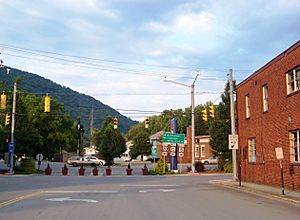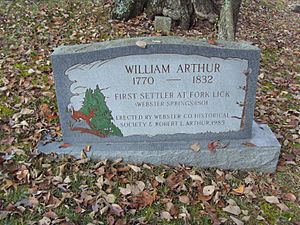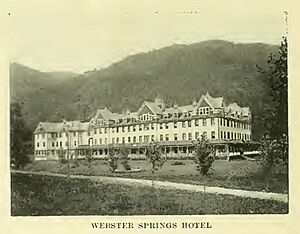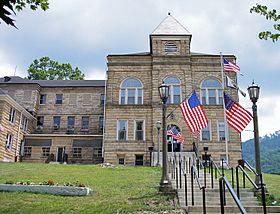Webster Springs, West Virginia facts for kids
Quick facts for kids
Webster Springs, West Virginia
|
|
|---|---|
| Addison, West Virginia | |

Webster Springs in January 2007
|
|

Location of Webster Springs in Webster County, West Virginia (left) and in West Virginia (right)
|
|
| Country | United States |
| State | West Virginia |
| County | Webster |
| Settled as: | Fort Lick in 1899 |
| Incorporated as (town): | Addison in 1945 |
| Named for | Addison McLaughlin |
| Area | |
| • Total | 0.47 sq mi (1.23 km2) |
| • Land | 0.45 sq mi (1.17 km2) |
| • Water | 0.02 sq mi (0.06 km2) |
| Elevation | 1,460 ft (445 m) |
| Population
(2020)
|
|
| • Total | 731 |
| • Estimate
(2021)
|
715 |
| • Density | 1,470.07/sq mi (568.16/km2) |
| Time zone | UTC-5 (Eastern (EST)) |
| • Summer (DST) | UTC-4 (EDT) |
| ZIP Code |
26288
|
| Area code(s) | 304 and 681 |
| FIPS code | 54101 |
| GNIS feature ID | 1560603 |
| Website | Addison Official Website: https://local.wv.gov/Addison/Pages/default.aspx |
Addison, also known as Webster Springs, is a town in Webster County, West Virginia, United States. It is the main town and the county seat of Webster County. Even though it was officially named Addison in 1892, most people call it Webster Springs. This is the name of the town's post office. The town was named after Addison McLaughlin, who owned the land where the town was first built. In 2020, about 731 people lived there.
In the late 1800s and early 1900s, the town was famous for its many salt sulfur water wells. People thought the water from these wells could help with health problems.
Webster Springs is located where the Elk River meets its Back Fork. The town has many shops, stores, and restaurants. You can also find government offices for the town, county, and state here. The Addison Public Library serves the town, and the Webster Springs Volunteer Fire Department provides fire services.
Contents
What's in a Name?
The town's official name is "Addison." However, people usually call it "Webster Springs," which is the name of its post office. Some maps show it as "Addison," while others show "Webster Springs." The unofficial name is so common that even the county's official letters use "Webster Springs" now.
In the past, the town was also known by other names like Elk Lick and Fork Lick.
Town History
The first people to live permanently in the town were William and Polly Arthur. They arrived in 1860. The first post office in Webster County was called Fort Lick, which is now Webster Springs. John Hall was the postmaster at that time. Webster Springs is also the county seat of Webster County.
The Morton House is an important historical building. It was added to the National Register of Historic Places in 1986.
Salt Sulfur Wells and Their Uses
John Hall and a man named Mr. Skidmore drilled the first salt sulfur well in the county. It was known as "Old Spring." Later, Colonel John T. McGraw owned this well. The salt sulfur wells made Webster Springs a very popular place for tourists in the summer during the 1800s and early 1900s.
According to a book called Springs in West Virginia, Webster Springs had four main springs. These included the Addison McLaughlin Well, the Old Fork Lick Spring, the Tracy Well, and the William Smith Well. People believed that the water from these wells had special healing powers. They used the water to help with skin problems like psoriasis, eczema, acne, and even arthritis.
The Grand Webster Springs Hotel
In 1897, Senator Johnson Newlon Camden built the Webster Springs Hotel. This huge hotel had 265 rooms and was built in the Victorian style. It was even bigger than The Greenbrier Hotel, which was built later in 1913.
The hotel offered many fun things to do. It had a tennis court, horse stables, a garden, and a bowling alley. It also had Russian and Victorian Turkish baths. Visitors could enjoy the "medicinal" salt sulfur waters in these baths. The Webster Springs Hotel was the largest wooden hotel in West Virginia.
When it was first built, the hotel was a dark color. Later, a much larger part was added, with more rooms and a new white exterior. The new section had modern Turkish bath equipment for sulfur water baths. For many years, the hotel was full of guests. So many people came that smaller hotels had to be built in the town. The hotel even raised its own cattle for food and milk. Its ice house could hold 150 tons of ice, and the hotel was heated by steam.
Inside, the hotel was decorated with stuffed bears, elks, and other local wildlife. These animals were arranged to look very real.
At its most popular time, the hotel welcomed important guests. These included Senators Thomas Kearns from Utah, Henry G. Davis from West Virginia, and his son-in-law, Stephen Benton Elkins, also from West Virginia. Senator Camden, who built the hotel, also stayed there.
Sadly, on the night of July 20, 1925, the hotel caught fire. It was completely destroyed. People could see the flames from a mile away. The sky glowed bright red up to 19 miles away, in Camden-on-Gauley.
Geography and Climate
Webster Springs is located at 38°28′34″N 80°24′36″W / 38.47611°N 80.41000°W. It sits along the Elk River. The town covers about 0.47 square miles (1.23 square kilometers). Most of this area is land, with a small part being water. The town is about 1,460 feet (445 meters) above sea level. It is also near Buffalo Bull Knob, a mountain that is 2,799 feet high.
Local Climate
The weather in Webster Springs has mild changes between high and low temperatures. There is also enough rain throughout the year. According to the Köppen Climate Classification system, Webster Springs has a marine west coast climate. This means it has cool, but not freezing, winters and mild summers.
Population Facts
| Historical population | |||
|---|---|---|---|
| Census | Pop. | %± | |
| 1880 | 120 | — | |
| 1900 | 297 | — | |
| 1910 | 500 | 68.4% | |
| 1920 | 679 | 35.8% | |
| 1930 | 976 | 43.7% | |
| 1940 | 1,133 | 16.1% | |
| 1950 | 1,313 | 15.9% | |
| 1960 | 1,132 | −13.8% | |
| 1970 | 1,038 | −8.3% | |
| 1980 | 939 | −9.5% | |
| 1990 | 674 | −28.2% | |
| 2000 | 808 | 19.9% | |
| 2010 | 776 | −4.0% | |
| 2020 | 731 | −5.8% | |
| 2021 (est.) | 715 | −7.9% | |
| U.S. Decennial Census | |||
2020 Census Information
In 2020, the census showed that 731 people lived in Webster Springs. There were 436 households in the town. Most of the people, about 97.2%, were White. A small number were African American (0.3%), Native American (0.1%), or from two or more races (2%). About 0.5% of the population were Hispanic or Latino.
The average age of people in the town was 34.2 years old.
Notable People
- Joe Talbott, a Delegate for the 36th District.
- Forest Dewey Dodrill, a doctor who was a pioneer in heart surgery.
- Walt Helmick, the West Virginia Commissioner of Agriculture.
See also
 In Spanish: Addison (Virginia Occidental) para niños
In Spanish: Addison (Virginia Occidental) para niños





